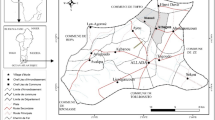Abstract
The severity and increase of the Imperata cylindrica constraint as a weed, the decline of the traditional fallow systems as a means of soil fertility management and the lack of inorganic fertilizer appear to have created opportunities for adoption of mucuna (Mucuna pruriens) technology by smallholder farmers in some areas in the derived savanna of West Africa. What is not known, however, is the extent to which the establishment and N contribution of mucuna in these areas depend on symbiotic properties such as effective nodulation and mycorrhizal infection. Short term surveys carried out in 34 farmer's arable fields located in four different sites in the derived savanna, southern Benin, West Africa, together with results of greenhouse and field experiments showed that mycorrhizal infection rate of mucuma ranged from 2 to 31% and correlated positively with nodulation and shoot dry matter production. Nodulation occurred in 79% of the fields with numbers of nodules ranging from 0 to 135 plant−1. Mucuna responded both to inoculation and N fertilizer in degraded soils but growth response depended on the rhizobia strains and mucuna varieties. Mucuna accumulated in 12 weeks about 313 kg N ha−1 as either a sole crop or 166 kg N ha−1 when mixed/intercropped with maize, respectively. Across all cropping systems it derived an average of 70% of its N from atmospheric N2 (estimates made by the 15N isotope dilution method), representing 167 kg N ha−1 per 12 weeks in the field. Mucuna interplanted with maize obtained a greater proportion of its nitrogen (74%) from fixation than did mucuna grown alone (66%) suggesting that competition for soil N influences the proportion of nitrogen fixed by mucuna. The total amount of N2 fixed per hectare was, however, reduced significantly by intercropping mucuna with maize. A preceding mucuna crop provided a maize yield equivalent to 120 kg N kg ha−1 of inorganic N fertilizer.
Similar content being viewed by others
References
Alexander M 1965 Most-probable-number method for microbial populations. In Methods of Soil Analysis. Part 2. Chemical and Microbiological properties. Eds. C ABlack and D DEvans. American Society of Soil Science, USA.
Akobundu I O 1987 Weed Science in the Tropics: Principles and Practices. John Wiley and Sons, Chichester, UK. 522p.
Buckles D 1994 Velvetbean: A “new” plant with a history. CIMMYT Internal Document. CIMMYT, Mexico, D.F 21p.
Bushby H V A, Date R A and Sundran J 1986 Rhizobium collections and their assessment. In Forages in Southeast Asian and South Pacific Agriculture. Eds. G JBlair, D AIvory and T REvans. pp 133–140 ACIAR, Canberra.
Cadisch G, Sylvester-Bradley R and Nösberger J 1989 15N based estimates of nitrogen fixation by eight tropical forage-legumes at two levels of P:K supply. Field Crops Res. 22, 181–208.
Collaborative Maize Base Systems COMBS 1992 Soil fertility improvement and weed suppression through legume based technology. An approach to technology targeting. Collaborative Research paper No. 1. IITA, Ibadan, Nigeria.
Date R A 1977 Inoculation of tropical pasture legumes. In Exploiting the Legume-Rhizobium Symbiosis in Tropical Agriculture. Eds. J M Vincent, A S Whitney and J Bose. University of Hawaii College of Tropical Africulture Special Publication No. 145, pp 293–311.
Dreyfus B L and Dommergues Y R 1981 Nodulation of Acacia species by fast- and slow growing tropical strains of Rhizobium. Appl. Environ. Microb. 41, 97–99.
FAO 1992 Annual report 1992. FAO, ROME, Italy.
Fried M and Middelboe V 1977 Measurement of amount of nitrogen fixed by a legume crop. Plant and Soil 47, 713–715.
Giavonnetti M and Mosse B 1980 An evaluation of methods for measuring vesicular-arbuscular infection in roots. New Phytol. 84, 489–500.
Giller K E and Wilson K J 1991 Nitrogen Fixation in Tropical Cropping systems. CAB International Wallingford, UK. 313p.
IITA 1989 Analytical manual. IITA, Ibadan, Nigeria.
Mulongoy K and Akobundu I O 1990 Agronomic and economic benefits of nitrogen contributed by legumes in live-mulch and alley cropping systems. In Nitrogen Fixation: Achievements and objectives. Eds. P MGresshoff, L ERoth, GStacey and W ENewton. pp 625–632. Chapman and Hall, New-York.
Sanginga N, Mulongoy K and Ayanaba A 1989 Effectivity of indigenous rhizobia for nodulation and early-nitrogen fixation with Leucaena leucocephala grown in Nigerian soils. Soil Biol. Biochem. 21, 231–235.
Sylvester-Bradley R, Souts S M and Date R A 1990 Rhizosphere biology and nitrogen fixation of Centrosema. In Centrosema- Biology, Agronomy and Utilization. Eds. RSchultze-Kraft and R JClements. pp 151–174. CIAT, Cali Colombia.
Trinick MJ 1980 Relationships amongst the fast growing rhizobia of Lablab purpureus, Leucaena leucocephala, Mimosa spp., Acacia farnesiana, Sesbania grandiflora and their affinities with other rhizobia groups. Bacteriol. 49, 39–53.
van Keulen H and van Heemst H D J 1982 Crop response to the supply of macronutrients. Agric. Res. Rep. 916 (Versl. Landbk. Onderz,) Pudoc, Wageningen, the Netherlands.
Van der Meersch M K 1992 Soil fertility aspects of alley cropping systems in relation to sustainable agriculture. Diss. de Agricultura. Leuven, Belgium. 179 p.
Vincent J M 1970 A manual for the Practical study of Root-Nodule Bacteria. IBP Handbook No. 15. Blackwell, Oxford, UK.
Versteeg M V and Koudokpon V 1990 Mucuna helps control Imperata cylindrica in southern Benin. West African Farming Systems Research Network (WAFSRN) Bull. 7, 7–8.
Weaver R W and Frederick L R 1972 A new technique for most probable-number counts of rhizobia. Plant and Soil 36, 219–222.
Weber G, Smith F and Manyong V M 1995 System dynamics and definition of research domains for the northern Guinea savanna of West Africa. Agric.Ecos. Environ. (In press).
Woomer P, Singleton P W and Bohlool B B 1988 Ecological indicators of native rhizobia in tropical soils. Appl. Environ. Microbiol. 54, 1112–1116.
Author information
Authors and Affiliations
Rights and permissions
About this article
Cite this article
Sanginga, N., Ibewiro, B., Houngnandan, P. et al. Evaluation of symbiotic properties and nitrogen contribution of mucuna to maize grown in the derived savanna of West Africa. Plant Soil 179, 119–129 (1996). https://doi.org/10.1007/BF00011649
Received:
Accepted:
Issue Date:
DOI: https://doi.org/10.1007/BF00011649



